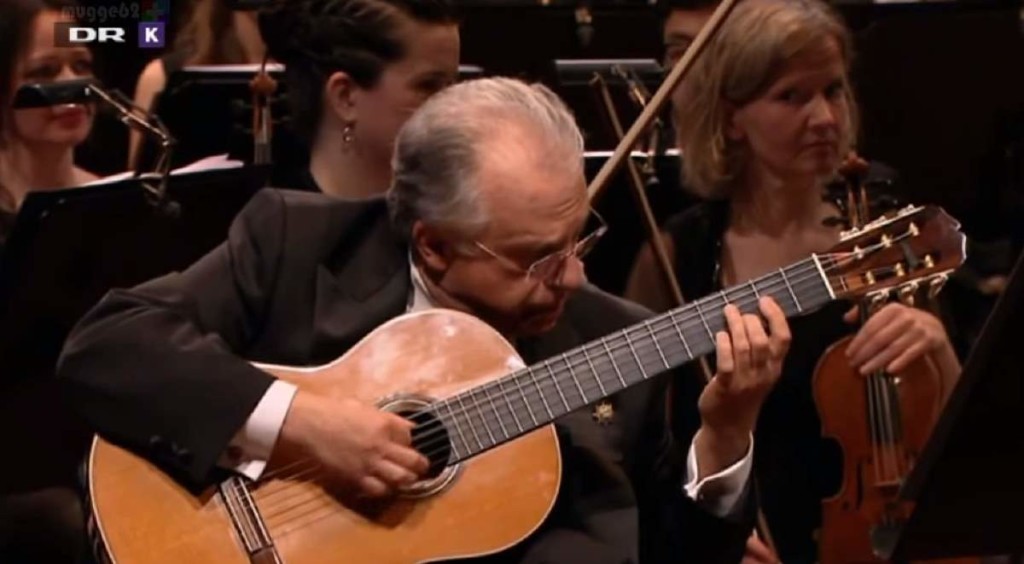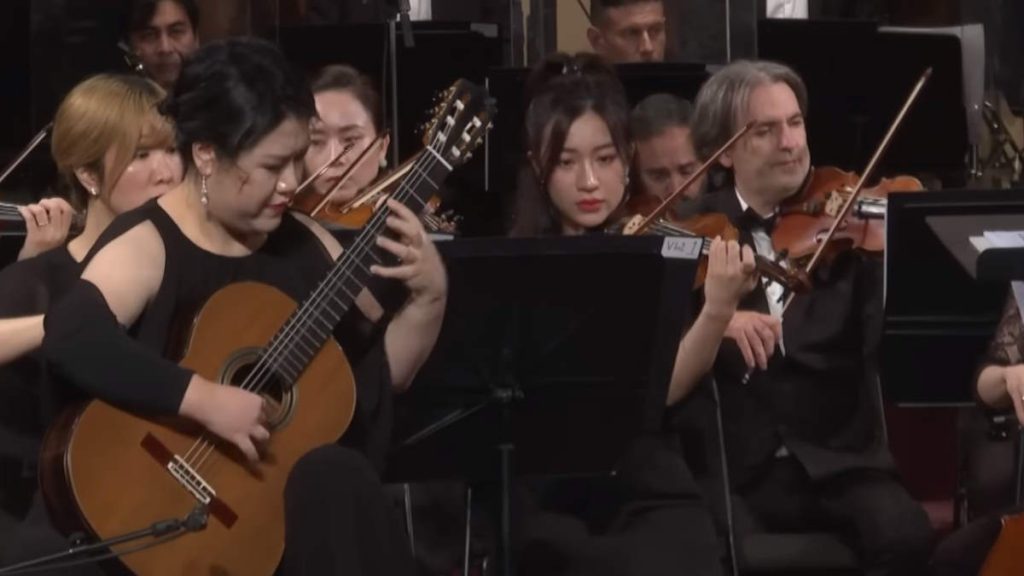Accompanied by the Orquesta Filarmónica de Santiago (Santiago Philharmonic Orchestra), the legendary Spanish classical guitarist Narciso Yepes performs Joaquín Rodrigo’s Concierto de Aranjuez on his 10-string guitar. Conductor: Rafael Frühbeck de Burgos. Also known as “Rodrigo’s Guitar Concerto”, the piece is perhaps the most popular guitar concerto ever written. This performance was recorded at the Teatro Municipal de Santiago, Chile in 1988. The concerto was followed by three encores: Francisco Tárrega’s “Recuerdos de la Alhambra”, “Brian Boru’s March” (a traditional Irish tune), and David Kellner’s “Phantasia No. 2”.
Joaquín Rodrigo’s Concierto de Aranjuez
Rodrigo’s Concierto de Aranjuez is a renowned guitar concerto composed by Spanish composer Joaquín Rodrigo in 1939. It is widely celebrated as one of the greatest compositions for the classical guitar and is known for its vibrant orchestration and evocative melodies that capture the essence of Spanish culture and landscapes.
The concerto was inspired by the gardens at the Royal Palace of Aranjuez, a historical residence of the Spanish monarchy. Rodrigo sought to reflect the beauty, tranquility, and grandeur of these gardens in his music. The piece combines elements of traditional Spanish folk music with classical techniques, creating a unique and engaging sound.
Rodrigo, who was blind from the age of three, composed the Concierto de Aranjuez by dictating the music to his wife, Victoria Kamhi. The premiere of the concerto took place in Barcelona in 1940, and it quickly gained popularity, becoming a staple of the guitar repertoire.
The Concierto de Aranjuez is notable for its rich orchestration and the way it allows the guitar to shine as a solo instrument, even against the backdrop of a full orchestra. The interplay between the guitar and the orchestra is intricate and beautifully balanced, showcasing Rodrigo’s skill as a composer.
The concerto has been recorded and performed by many distinguished guitarists and orchestras worldwide. It continues to be a beloved work, admired for its emotional depth, technical brilliance, and its ability to transport listeners to the lush gardens of Aranjuez.
Movements
1. Allegro con spirito
The first movement of Rodrigo’s Concierto de Aranjuez is marked Allegro con spirito, reflecting its lively and spirited nature. This movement sets the tone for the concerto with its energetic and rhythmic drive, capturing the listener’s attention from the very beginning.
The movement begins with a distinctive rhythmic motif played by the orchestra, immediately establishing a vibrant and dynamic atmosphere. This is soon followed by the entrance of the solo guitar, which introduces a series of virtuosic and melodic passages. The interplay between the soloist and the orchestra is a hallmark of this movement, with the guitar often taking the lead and the orchestra providing a rich and colorful accompaniment.
Rodrigo’s use of Spanish folk elements is evident in the rhythmic patterns and melodic lines, which evoke the spirit of traditional Spanish music. The guitar part features rapid scales, arpeggios, and intricate fingerwork, showcasing the technical prowess required of the soloist.
Throughout the movement, there is a constant dialogue between the guitar and the orchestra, with each taking turns to develop the thematic material. The music is characterized by its bright, rhythmic energy and its ability to evoke images of the Spanish landscape and culture.
The Allegro con spirito concludes with a dynamic and rousing finale, bringing the movement to an exhilarating close. This movement is a testament to Rodrigo’s skill in blending classical form with the essence of Spanish folk music, creating a piece that is both technically demanding and emotionally engaging.
2. Adagio
The second movement of Rodrigo’s Concierto de Aranjuez is marked Adagio and is the most famous and emotionally evocative part of the concerto. It is renowned for its hauntingly beautiful and melancholic melody, which is introduced by the English horn. This movement stands in stark contrast to the lively first movement, offering a deep sense of introspection and lyrical beauty.
The movement begins with a slow, plaintive melody played by the English horn, supported by a gentle orchestral accompaniment. This theme is both sorrowful and serene, setting a reflective mood. The solo guitar then enters, echoing the melody introduced by the English horn and elaborating on it with delicate and expressive phrasing.
The guitar and the orchestra engage in a tender and poignant dialogue throughout the movement. The guitar’s role is particularly significant, with intricate fingerwork and expressive dynamics that bring out the emotional depth of the music. Rodrigo’s writing for the guitar in this movement showcases the instrument’s ability to convey a wide range of emotions, from quiet introspection to passionate intensity.
The orchestration is subtle and supportive, allowing the guitar to shine while providing a rich harmonic background. The interplay between the soloist and the orchestra is carefully crafted, with each complementing the other to enhance the overall emotional impact of the movement.
One of the most striking features of the Adagio is its use of contrast. The movement alternates between sections of lyrical beauty and moments of dramatic intensity, creating a powerful emotional journey for the listener. The climactic moments are particularly moving, with the guitar and orchestra building to powerful crescendos before returning to the tranquil and reflective mood of the opening.
The Adagio ends with a return to the serene and plaintive mood of the beginning, bringing the movement to a peaceful and contemplative close. This movement is often interpreted as a reflection on loss and longing, and its emotional depth and beauty have made it one of the most beloved pieces in the classical guitar repertoire.
3. Allegro gentile
The third movement of Rodrigo’s Concierto de Aranjuez is marked Allegro gentile, providing a lively and graceful conclusion to the concerto. This movement contrasts with the introspective second movement, bringing back the energy and brightness of the opening movement, but with a lighter and more playful character.
The Allegro gentile starts with a rhythmic and buoyant theme introduced by the orchestra, immediately setting a cheerful and dance-like tone. The solo guitar soon joins in, echoing this theme and adding its own embellishments and variations. The movement is characterized by its rhythmic vitality and the intricate interplay between the guitar and the orchestra.
Rodrigo employs elements of Spanish dance rhythms throughout this movement, which contributes to its lively and spirited feel. The guitar part is filled with rapid scales, arpeggios, and intricate passagework, showcasing the technical skill of the soloist. Despite the technical demands, the music maintains a light and airy quality, embodying the “gentile” aspect of the movement’s marking.
Throughout the movement, the thematic material is passed back and forth between the guitar and the orchestra, creating a dynamic and engaging dialogue. Rodrigo’s orchestration is colorful and varied, with different sections of the orchestra adding their own timbral contributions to the overall texture.
The Allegro gentile features several contrasting sections, where the mood shifts from lively and exuberant to more lyrical and reflective, before returning to the upbeat main theme. This alternation between different moods adds to the movement’s charm and keeps the listener engaged.
As the movement progresses, the music builds in excitement and intensity, leading to a spirited and joyful conclusion. The final passages are marked by their exuberance and virtuosity, bringing the concerto to a rousing and satisfying close.
Sources
- Concierto de Aranjuez on Wikipedia
- “Rodrigo’s Concierto de Aranjuez: the pinnacle of the guitar concerto” on the Bach Track website
- El Concierto de Aranjuez on Joaquin-Rodrigo.com
![Rodrigo: Concierto de Aranjuez [Narciso Yepes]](https://andantemoderato.com/wp-content/uploads/2023/12/Narciso-Yepes-Concierto-de-Aranjuez-Moscow-1980-1024x576.jpg)

